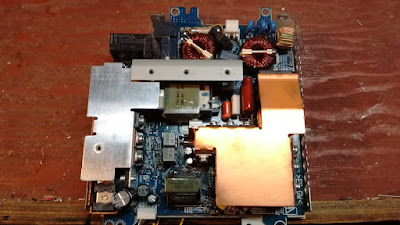AC9LF's Findings with a FCC and CE labeled product I purchased on Amazon recently.
Here's
a link to a similar product. The original that I bought seems to be
missing. This one appears to have the same power supply.
I
sent inquiries to the seller about this issue with no response after
several days so I sent a product review in with my concerns today. (They did eventually respond but only offered to send a replacement. This of course will not work since it is a problem with the product not the individual part. They need to use a real tested and compliant power supply.)
To save my wrists I will paste the review I sent in below and attach the associated images.
-------
I purchased two of these LED light strips one for my wife for Christmas and one for my brother-in-law who is also my neighbor. I didn't realize however when I was buying this that I was also buying a problem. Don't get me wrong, the lights themselves are pretty neat, very colorful and lots of cool patterns to play with.
Almost
immediately after installing these lights I noticed that when the
lights were on, my radio receivers were affected by a terribly high level
of noise or radio frequency interference (RFI). Even when the lights
were "off" or in "standby" there was still a significant amount of noise
being generated by the device. I tried numerous ferrite chokes on the
outside wires with little effect. It seemed the noise being generated
was likely being conducted on to the utility power lines.
Attached
is an image of my radio receiver, one of them, showing almost 20dB over
s9. It would be impossible to hear any other signals under this noise.
My VHF radio was also effected with about an S5. So this horrendous RF
noise is very broadband. The antennas for these radios are nowhere near
the lights.
I
narrowed it down to the power supply included with the LED strip by
using an external battery instead. The noise all but vanished using the
battery as it's power source instead. As a sanity check I used a known
high-quality 12 volt power supply I had on hand. It's used typically for
radio communications and was also mains utility powered. In both cases
the huge amount of noise was eliminated.
Looking
closer at the power supply it has an FCC mark (tested to a standard for
RF noise emissions as an unintentional radiator which is required by
the US federal code of regulations) and a CE mark on it (Tested to
European standards for safety, immunity and RF emissions). However, I
was highly suspicious of this. If you look up the official marks for
both CE and FCC there are some differences. An image of the assembled
and disassembled power supply are attached.
I'm
not sure the manufacturer did any safety or EMC testing on it. I work
as an Electrical/Electronic Engineer so I had access to some equipment
to do a bench test conducted RF emissions scan. I have attached the
results and there is no way this power supply/product passes the
required test as you can see. The purple line is the upper limit for
quasi peak the vertical axis is in dB. The yellow
line is the scan of the peak emissions from the power supply under full
load. The limit lines are based on CISPR-14 since that was a previous
test I was doing but the lines are about the same for FCC part 15 class B
devices which are marketed to residential consumers.
This
device with this power supply should not be sold. As you can see from
the attached photos there is absolutely no input filtering on this power
supply. It's also very likely it has never been tested to any safety standard
like UL or ETL. There is no UL or ETL mark on it. These third-party US
safety compliance bodies should be used to test products anytime the product is
plugged into a wall or generates heat.
I would
recommend the supplier or manufacturer do their homework and use a
proper UL or ETL listed power supply for this product. On top of this,
request the actual test data to verify the device passes EMC testing to
continue selling it.
I
purchased a different power supply myself that is UL listed and FCC
compliant. I tested it and I no longer have the severe noise.
Now I have to fix my brother-in-law's Christmas present so it doesn't cause me or others problems.
Buyer beware.
--------
As
a side note I had a similar experience a couple years back with data
from a Noco brand battery charger. No input EMI
filters on their US version. They claimed there was nothing in the US
that required EMC compliance of their US product. Their CE version had
these filters.














































